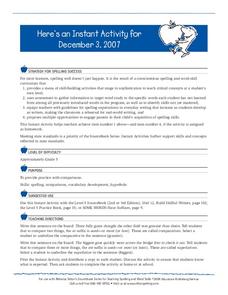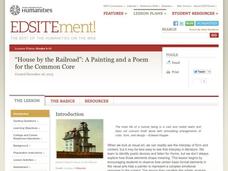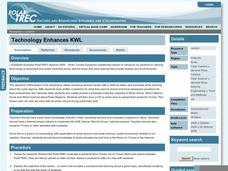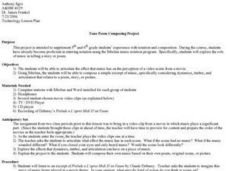Curated OER
Half Man, Half Limping Rabbit
Students explore culture and change through reading "Half Main, Half Limping Rabbit" by Nina Porzucki. In this literature and cultural instructional activity, students discuss Dracula and other folk stories from Romania. Students...
Curated OER
Lesson Plan 8: Setting and Mood
What mood does this story evoke? How are setting and mood linked? Young novelists explore the different emotions brought about by writing, starting by journaling things that inspire their own feelings. Examine the word mood, looking into...
Curated OER
Reading Examples
Young writers read excerpts from Gary Paulsen's memoir to identify figurative and literal language that contain sensory details. They determine which selections are examples of sensory language and fi the language is used literally or...
Curated OER
Sound poems
Third graders write a class poem based on the use of sound to create effects. They investigate use of onomatopoeia and how to write in a tight structure.
Curated OER
Citizenship
Students investigate patterns of immigration in the US while comparing and contrasting the ideas of citizenship and non-citizenship. They decide how education plays a role in citizenship.
Curated OER
Orienteering - Lesson 2 - Topographical Maps
One of the most important skills in orienteering is being able to read a topographical map. Understanding the contour lines and symbols and the scale of the map will make planning your route so much better. In this lesson, partners get...
Curated OER
Coming Home:From the Life of Langston Hughes
Third graders listen to the non-fiction book: COMING HOME: FROM THE LIFE OF LANGSTON HUGHES. They identify examples of metaphors and similies within the book and understand how this figure of speech is used in writing. They then create...
Curated OER
Comparisons
Fifth graders complete a worksheet. In this comparison lesson, 5th graders view sentences and identify the comparatives in them. Students complete a worksheet on comparisons.
Curated OER
"Knot" the Whole Truth: Writing a Modern-Day Story with a Tall Tale's Voice
Beyond Paul Bunyan and his blue ox, tall tales can be a great way to teach young writers about word choice and voice in their writing. Using Jerry Spinelli's Maniac Magee and the Six-Trait Writing process, they begin to write...
Curated OER
Introduction to Edgar Allan Poe
Before reading Edgar Allan Poe's "The Raven" in your class, walk learners through this scavenger hunt that teaches them about Poe's life and works. Though the lesson plan is designed for 15:1 special education class, it could work in any...
Curated OER
Similes and Metaphors: An Interactive Review
Get your pupils' attention with this lesson on similes and metaphors, which features two poems by Tupac Shakur. A SMART board presentation guides them through the lesson, which includes a BrainPop activity (linked). After they have...
National Endowment for the Humanities
“House by the Railroad”: A Painting and a Poem for the Common Core
Introduce your class to ekphrastic poetry with an exercise that asks them to examine Edward Hooper's painting House by the Railroad and Edward Hirsch's poem "Edward Hopper and the House By the Railroad." After a close reading...
National Endowment for the Humanities
Thirteen Ways of Reading a Modernist Poem
High schoolers analyze modernist poetry and the role of speaker in example poems. Learners study modernist poems from the Romanticism and Victorian periods as well as Wallace Stevens' "Thirteen Ways of Looking at a Blackbird." Using a...
Maryland Department of Education
The Concept of Diversity in World Literature Lesson 4: Proverbs
"Eneke the bird says since men have learnt to shoot without missing, he has learnt to fly without perching." As part of their study of Things Fall Apart, class members read Paul Hernadi and Francis Steen's essay, "The Tropical Landscapes...
Polar Trec
Technology Enhances KWL
To introduce learners to the ways people share information through the use of technology, the class makes podcasts. Each child chooses anything he is curious about regarding the Arctic or Antarctic regions. Learners then complete a KWL...
Curated OER
Say Hi to Haibun Fun
Students examine the Japanese writing form of Haibun. They identify the elements of Japanese prose and poetry, analyze a haibun for writing devices, complete a graphic organizer, and compose an original haibun as a form of journal keeping.
Curated OER
Lesson: Urs Fischer: Reviving the Past Art Movements
Seven major abstract art movements are analyzed by learners in groups. Each group analyzes various works by determining which work belongs to which movement. They then read Flatland, engage in an art and literary analysis discussion,...
Curated OER
Practicing Literary Analysis
Ninth graders analyze the poem, "The Rime of the Ancient Mariner." They read, discuss, and critique the poem in small groups focusing on plot and figurative language. They compose a short essay explaining how various literary elements...
Curated OER
Product Design and Production in the Global Economy
Eleventh graders explore the design, manufacture and consumption of personal audio devices and cellular products. They examine the related issues, choices, and consequences in the global economy for such purchases. They research...
Curated OER
Comparatively Speaking
Students practice creating similes and metaphors together as a class. Individually students create similes and metaphors and illustrate them.
Curated OER
Creating Sentences with Onomatopoeia Words
Third graders create sentences. In this sentences lesson students use onomatopoeia words to write sentences. They make a movement to match their onomatopoeia word. The students discuss why an author might use onomatopoeia in their writing.
Curated OER
Tone Poem Composing Project
Students explore role of music in storytelling by watching and discussing effect music has on perception of scene from movie, and using Sibelius program to compose single excerpt of music, considering dynamics, timbre, and articulation,...
Curated OER
Tall Tales Today
Young scholars explore the attributes of American tall tales. In this folklore lesson, students read several tall tales, describe the elements of tall tales, and then use hyperbole to write their own tall tales.
Curated OER
Goddesses Are Personifications Too!
Students explore the use of personification as a way of expressing ideals. They transfer this understanding to the present by creating an allegorical depiction of a contemporary ideal or value inspired by precedents in the...























